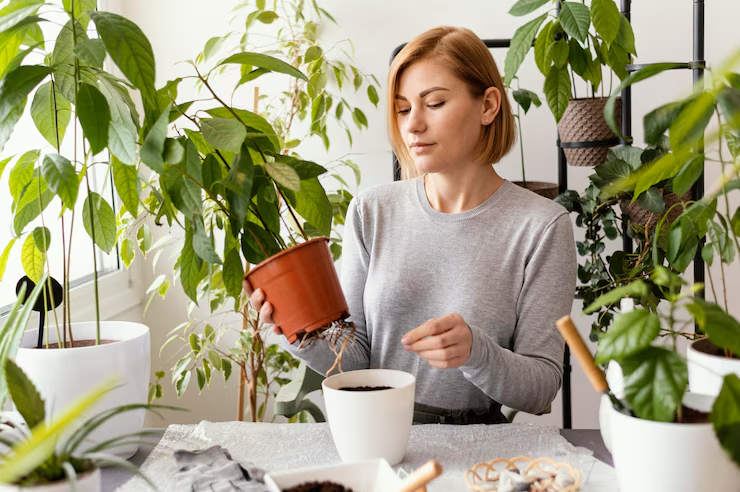How to Get Rid of Bugs on Indoor Plants
- Staff Desk
- Jun 28
- 3 min read

Indoor plants bring life, color, and cleaner air to our homes, but they can also attract unwanted pests. If you've noticed tiny insects crawling on your beloved houseplants or leaves with spots and holes, you're not alone. Indoor plant pests are a common problem, but with the right knowledge and approach, you can eliminate them and prevent future infestations.
🤦 Common Bugs Found on Indoor Plants

Before treating your plant, it's important to know what you're dealing with. Here are the most common indoor plant pests:
Bug | Appearance | Damage Signs |
Aphids | Pear-shaped, soft-bodied; green, black, or white | Sticky residue, curled/deformed leaves |
Spider Mites | Tiny, red or yellow, web-spinning | Stippling, yellowing leaves, fine webbing |
Mealybugs | White, cotton-like clusters | Leaf yellowing, stunted growth |
Fungus Gnats | Small black flies near soil | Wilting, poor soil drainage, root damage |
Scale Insects | Brown or black hard bumps on stems | Sap-sucking, yellowing leaves, stunted growth |
Whiteflies | Tiny white flying insects | Leaf yellowing, honeydew, mold growth |
🌿 Natural Treatments for Indoor Plant Bugs

✅ 1. Neem Oil Spray
Neem oil is an all-natural pesticide that is effective against most soft-bodied pests.
How to Use:
Mix 1 tablespoon of neem oil with 1 quart of water and a few drops of dish soap
Spray on leaves (top and bottom) and stems
Apply every 4–7 days for 3–4 weeks
🌺 2. Rubbing Alcohol (Isopropyl)
Kills insects on contact, especially effective against mealybugs and scale.
How to Use:
Dab a cotton swab in 70% isopropyl alcohol and apply directly to pests
Alternatively, mix 1 part alcohol to 4 parts water and spray affected areas
💦 3. Soap & Water Spray
Dish soap breaks down pest exoskeletons.
How to Use:
Mix 1 teaspoon mild dish soap in 1 quart of water
Spray thoroughly and rinse after 2 hours
Repeat every few days
🌧️ 4. High-Pressure Water Spray
Effective for spider mites, aphids, and whiteflies.
How to Use:
Use a garden hose or shower head to blast pests off leaves
Repeat daily for 1 week
💫 5. Diatomaceous Earth
A fine powder that kills bugs by dehydrating them.
How to Use:
Sprinkle over the surface of dry soil and on plant leaves
Use only dry (not wet) for full effectiveness
💧 6. Hydrogen Peroxide Soil Soak
Effective against fungus gnats.
How to Use:
Mix 1 part hydrogen peroxide (3%) with 4 parts water
Pour into the soil until it drains from the bottom
Repeat weekly
🛡️ Chemical Treatments (For Severe Infestations)

If natural methods aren’t working, chemical insecticides may be needed.
🔹 Systemic Insecticides
Absorbed by the plant and poison pests feeding on it.
Look for products containing imidacloprid
🔹 Pyrethrin-Based Sprays
Botanical insecticides derived from chrysanthemum flowers.
Effective against a wide range of indoor pests
🔹 Insecticidal Soaps
Specially formulated to kill bugs without damaging plants.
Safer for home use than conventional pesticides
Warning: Always follow label directions and keep away from children and pets.
📅 Integrated Pest Management (IPM)
Step-by-Step Plan:
Inspect regularly – Check plants weekly
Identify the pest – Use magnifying glass and photos
Isolate infected plants – Prevent spreading
Apply treatment – Natural first, chemical if needed
Repeat as necessary – Bugs often return if not consistent
🌟 Prevention Strategies
✅ 1. Quarantine New Plants
Isolate new arrivals for 10–14 days
Monitor for signs of pests before placing them near others
🌫️ 2. Maintain Proper Humidity
Most bugs hate humidity above 60%
Use pebble trays, humidifiers, or group plants together
💻 3. Avoid Overwatering
Fungus gnats thrive in moist, poorly drained soil
Let soil dry slightly between watering
📊 4. Good Air Circulation
Use fans to increase airflow
Prevent stagnant, humid pockets that harbor pests
🌺 5. Clean Leaves Regularly
Wipe with damp cloth weekly
Removes dust, webs, and potential pests
💡 Tips for Specific Pests
💚 Aphids
Use a strong water blast and neem oil spray
Introduce ladybugs for natural control (in greenhouses)
🧬 Mealybugs
Remove with alcohol-soaked swab
Apply neem oil or insecticidal soap
🐞 Spider Mites
Increase humidity and apply neem oil daily
Use predatory mites (Phytoseiulus persimilis) for natural control
🐜 Fungus Gnats
Let soil dry out and use yellow sticky traps
Treat soil with hydrogen peroxide solution
🏆 Best Practices for Long-Term Success
Inspect weekly: Look under leaves and at soil surface
Clean pots & tools: Prevent cross-contamination
Repot if needed: Especially for root-infesting bugs
Fertilize wisely: Over-fertilizing can weaken plants and attract pests
📜 Trusted References
University of California IPM Program
Gardening Know How - Houseplant Pest Control
National Pesticide Information Center
🌟 Final Thoughts
Bugs on indoor plants can be frustrating, but they don't have to spell disaster. With consistent care, proper identification, and timely treatments, you can eliminate pests and restore your plants to health. Start with natural methods, escalate if needed, and always prioritize prevention.



Comments